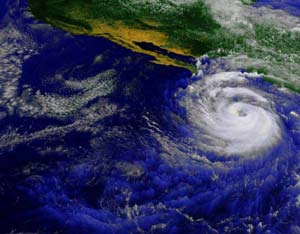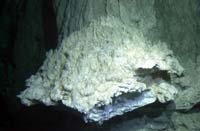Search Results for: Ocean

Hurricane Winds Carried Ocean Salt & Plankton Far Inland
Researchers found surprising evidence of sea salt and frozen plankton in high, cold, cirrus clouds, the remnants of Hurricane Nora, over the U.S. plains states. Although the 1997 hurricane was a strong eastern Pacific storm, her high ice-crystal clouds extended many miles inland, carrying ocean phenomena deep into the U.S. heartland.
Kenneth Sassen of the University of Utah, Salt Lake City, and University of Alaska Fairbanks; W. Patrick Arnott of the Desert Research Institute (DRI) in Reno,

A perfect storm of turbulent gases
Like the fury of a raging sea, this anniversary image from the NASA/ESA Hubble Space Telescope shows a bubbly ocean of glowing hydrogen, oxygen, and sulphur gas in the extremely massive and luminous molecular nebula Messier 17.
This Hubble photograph captures a small region within Messier 17 (M17), a hotbed of star formation. M17, also known as the Omega or Swan Nebula, is located about 5500 light-years away in the Sagittarius constellation. The release of this image commemorates the thirte
UCSB professor says volcanic eruptions in Costa Rica ’inevitable’
It might be 500,000 years or five years, but the Central Valley of Costa Rica will definitely experience major volcanic activity again, according to Phillip B. Gans, professor of geology at the University of California, Santa Barbara. He presented a study of volcanic rocks of Costa Rica in his recent talk at the annual meeting of the Geological Society of America.
“The Costa Ricans were not around for the last big one, but it’s inevitable,” said Gans. “Another pyroclastic flow like the
Whale study links genetics and reproductive success
Researchers compare reproduction rates in North Atlantic whales with genetic variation
A recent study focusing on the humpback whales of the Gulf of Maine revealed that differences in reproductive success of whale mothers may play a significant role in changing genetic variation in the population, according to scientists from the Wildlife Conservation Society (WCS), the American Museum of Natural History and their collaborators. Specifically, certain maternal lines of whales have prod

Scientists returning to field of eerie thermal spires
The bizarre hydrothermal vent field discovered a little more than two years ago surprised scientists not only with vents that are the tallest ever seen – the one that’s 18 stories dwarfs most vents at other sites by at least 100 feet – but also because the fluids forming these vents are heated by seawater reacting with million-year-old mantle rocks, not by young volcanism.
The remarkable Lost City hydrothermal vent field, so named partly because it sits on a seafloor mountain named the
UCLA biologists elucidate fertilization process
UCLA graduate student Jeffrey Riffell and UCLA biology professor Richard Zimmer report the first experimental test on the role of small-scale physics as it influences the interactions between sperm and egg, and the consequences for fertilization, at the annual conference of the Association for Chemoreception Sciences in Sarasota, Fla., April 10.
“The physics of fluid motion has a profound consequence on the ability of sperm to navigate and find an egg, and therefore on fertilization,” Zimmer